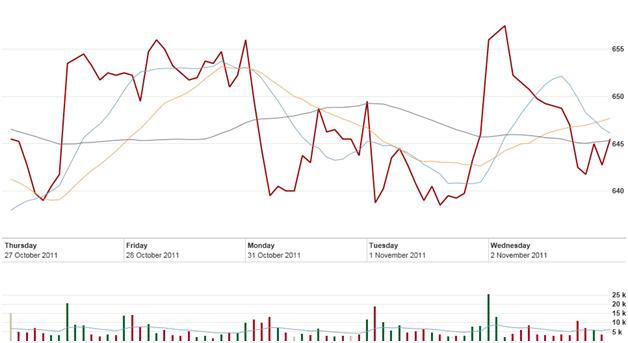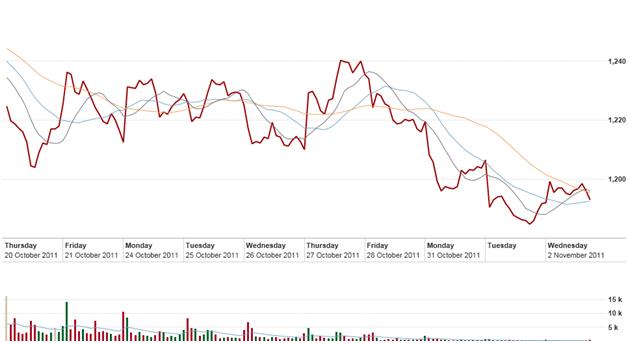Fundamental analysis: most news reports describe events that have probably already been priced into the market.
Strategy
- Key reports (non-farm payrolls, USDA crop reports, consumer confidence report, GDP growth, USDA export reports, etc.): can have a massive impact on prices the day they are released. Research predictions and forecasts from as many different sources as you can find leading up to the day the report is released and bid accordingly.
o Outside markets (European debt crisis, other commodities especially energy and precious metals): subscribe to RSS feeds and daily market summaries sent to your email like Telvent DTN that give you charts of changes in prices and suggest items of interest to watch throughout the week or the next day.
- I check my RSS feeds and daily summaries quickly to see if there are any key reports I should track. If not I keep the state of EU debt crisis in mind; if there was a new crisis during afterhours trading then I will lean towards a bearish outlook; if a new resolution to a problem might be reached then I lean towards bullish. If energy a gold/silver took a huge plunge in prices then I will research why and try to anticipate if it might affect agricultural commodities.
- I found Twitter to be an excellent source of information from my industrious classmates and other sources I was following.
Technical analysis:
- Overnight trading: one of my main early challenges was entering the market. I would always bid too high or too low.
o Solution: If you check the quote price after 4pm P.S.T. you will notice that trading is still occurring. This activity counts for the next day! The chart below shows the price for soybeans as of 8:11 pm on Friday Nov. 18, with a high price of 1177.4 and a low price of 1152.6, but the trading applies to Monday Nov. 21’s market day. So if I wanted to guarantee entering the market on Monday, I would go short at 1177.3 or long at 1152.7. The biggest risk even if you correctly guess if prices will go up or down is that, for example if prices fall and you go short, the high price rises to 1179.5 then you could have made more if you bid at 1179.4. Pivot points can be a solution to this.
- Daily graphs: I copied and pasted our trading game google.doc’s prices into an excel file to track my profits. Using these prices I created worksheets that track the following graphs. Every day I copy and paste the updated prices into my workbook, drag and drop down to update profits and changes in the following technical charts and bid accordingly. Excel is an excellent time saver.
o Corn minus Wheat Price Spread (https://blogs.ubc.ca/nchoykm/2011/10/27/week-of-october-24-28-trading-strategy/): I tried to see if there was a quantifiable link between the price of corn and wheat and noticed that there might be a preferred price differential of around 18 cents; if the price spread narrows to 10 cents for example then it will widen within a couple days. Fundamentals, like bad news out of Europe, will probably prompt the price to fall for both corn and wheat so I will bid short on wheat as it should fall by more. In the chart below, I employed this strategy on day 46 (Nov. 17) as the spread looked too narrow on day 45.
o Pivot points (https://blogs.ubc.ca/nchoykm/2011/11/11/week-of-november-7-11-trading-strategy/): I wish I had learned about pivot points a lot sooner than last week. I found them to be an excellent way to determine if there a commodity is gaining bearish/bullish momentum. Using Support 1 (S1) and Resistance (R1) prices to set my bid prices allowed me to take a risk by not only relying on overnight trading prices and if the market was making big movements then I use S2 and R2 in my analysis.
o Tie-breakers: sometimes fundamental analysis disagrees with technical analysis, or I might be on the fence. So the following tools were helpful to swing in me in one direction or the other. Unfortunately I learned about these tools before pivot points and I used them as primary tools for most weeks:
- Simple-moving averages (10, 20, 40 day)
- Moving Average Convergence Divergence (MACD)
- Commitment of Traders
Final Week Activity
I employed all the strategies listed above. On Nov. 14 I relied on news from outside markets that seemed bullish for soybeans so I kept my 3 open long contracts and then offset on Nov. 15 because I thought this was the last day we could trade in soy. Using technical analysis I managed to offset with almost no loss. Fundamentals research coupled with corn-wheat price spread worked out really well for me on Nov. 16 by going short on 2 contracts of wheat and pivot points helped me to offset on Nov. 17 and still make a profit.
|
Bid Prices |
||
|
Date |
Soy |
Wheat |
|
Nov-14 |
0 |
0 |
|
Nov-15 |
1171.9 |
0 |
|
Nov-16 |
0 |
632.3 |
|
Nov-17 |
0 |
607.8 |
|
Nov-18 |
0 |
0 |
Final margin balance: 36,945
Thanks to Jim, Andrew and Javier for the learning experience!



